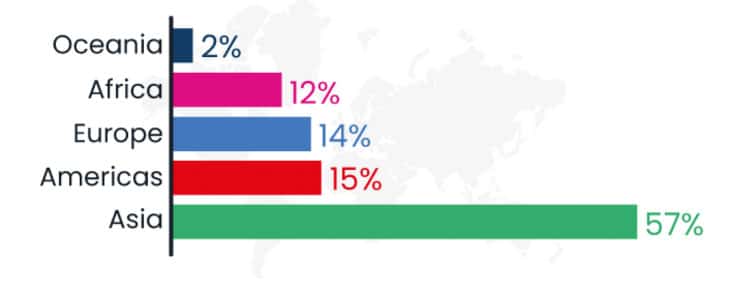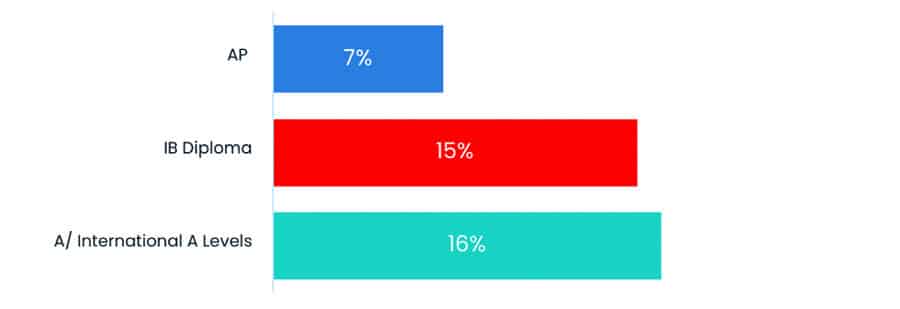International schools an increasingly important recruitment channel for higher education
- The number of international schools keeps expanding, with the highest numbers in China and India
- More than seven million students are enrolled all over the world
- Half of all schools are in Asia, but there are significant numbers in Africa, Europe, and the Americas
- The UK is especially attractive for many graduates of international schools, but awareness of the pros of European destinations such as Germany, Spain, Belgium, and the Netherlands is growing
International schools in target student sending markets have long represented a fruitful recruitment source for foreign educators, and there are now 14,460 of those schools around the world serving more than seven million students.
There has been significant growth in the sector over the past few years. ISC Research’s 2024 report, How Do International Schools Prepare Students for Higher Education?, shows that compared with five years ago, there are 10% more schools, 13% more students, 15% more staff employed, and 23% more fee income. Collectively, international schools generate about US$64 billion every year.
The implications for universities are huge. ISC notes:
“Data analysis from ISC Research indicates that approximately 580,000 students will have exited English medium international schools during the summer of 2024. With prior research indicating that over 90% of these students are expected to enter universities around the world, international schools are an invaluable source of prospective undergraduates for higher education institutions.”
Where are the schools?
More than half of international schools are in Asia.

Regional nuances
ISC presents highlights on where students from four important sending markets tend to go after completing studies at an international school:
- In China (1,103 schools enrolling close to 400,300 students), the top choice is the UK, and demand is falling somewhat for the US due to safety concerns or geo-political tensions.
- In Ghana (114 schools enrolling over 37,000 students), students tend to prefer the UK, US, and Canada, but are increasingly interested in European destinations because of their lower cost and simpler visa processes.
- In India (913 schools, close to 420,000 students), ISC notes a growing trend of staying in-country after studies because of an increase in foreign-affiliated universities and because students are worried about global economic instability. This trend is important given the hundreds of thousands of Indian students abroad today. In fact, over a million Indian students were hosted by just six countries in 2023: Canada (420K+), US (268K+), UK (173K+), Australia (126K+), and Germany (42K+). A dip from this market (which Canada is already experiencing) would be exceptionally difficult for many universities.
- In Saudi Arabia (332 schools, over 366,000 students), students are most interested in degree studies in the US, which is enabled by bilateral agreements between the US and Saudi Arabia. That said, Saudi Arabian enrolments in US colleges have declined every year since 2016. In 2022/23, the most recent year for which IIE Open Doors data are available, it was the only top 10 market to decline for the US (-12%).
The role of the college counsellor
An important section in the ISC report details the role of the college counsellor at international schools. That position is “integral to the higher education application process for students,” says ISC, and so foreign recruiters would do well to establish a good connection with the college counsellor at any of the international schools they are interested in.
ISC elaborates:
“In international schools, where students apply to universities in multiple countries, each with their own application system and requirements, college counsellors are invaluable in navigating these complexities, ensuring students are well prepared for success.
Most international schools and their college counsellors promote ‘best fit’ selection; they carefully match students’ study and pathway goals to an institution’s ethos, course offer, learning model, extracurricular opportunities, location, and study outcomes.”
The report includes a case study illustrating the responsibilities of Jinane Helou, a university counsellor at ABA Oman International School. Ms Helou’s responsibilities “go beyond academic guidance, focusing on holistic development, personalised support, and fostering strong relationships with universities.” The following excerpt provides an example of how ABA Oman interacts with universities:
“Each year universities are welcomed to ABA Oman to attend university fairs exposing students to a wide range of global higher education institutions. ABA Oman also has a partnership with the Lucerne University of Applied Sciences and Arts in Switzerland, which sets aside places for ABA Oman students each academic year. Such partnerships not only enhance the school’s reputation but also provide students with a smoother transition to university life."
Curricula and exams
One or more of the following curricula are offered at most international schools.

The following chart indicates the qualifications preferred by students at international schools. The A/ International A levels are naturally attractive to student with their hearts set on study in the UK

For more information, please see:
















